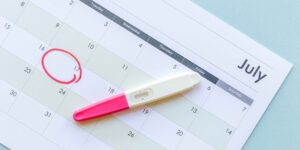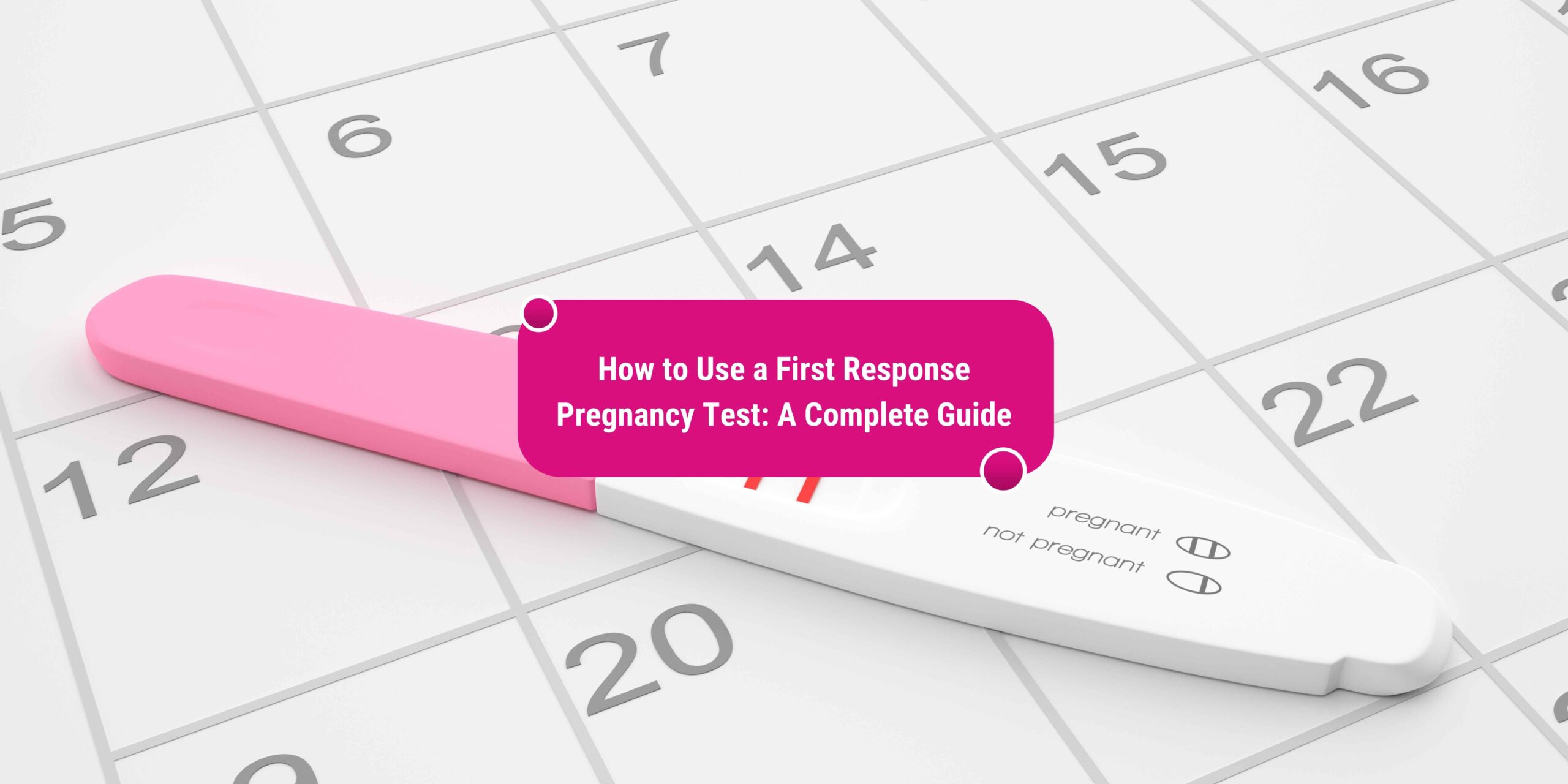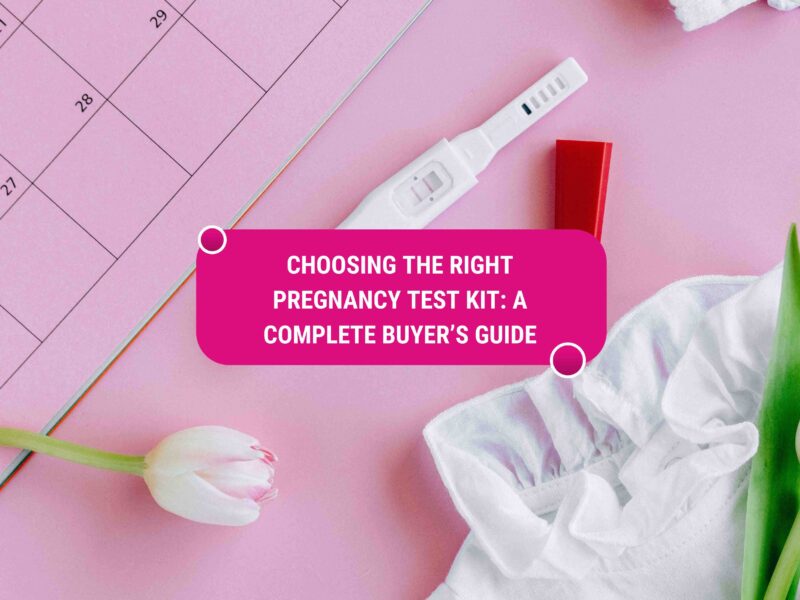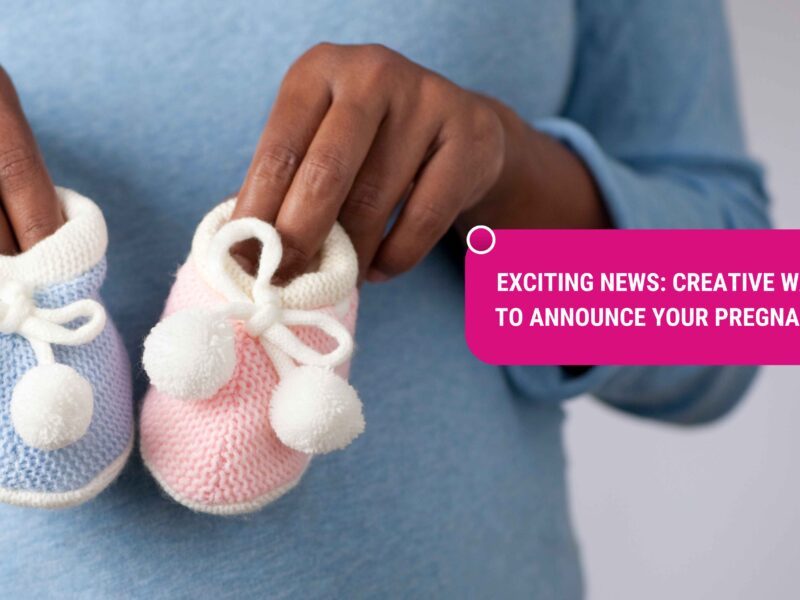First Response Pregnancy Tests
At any drugstore, you are likely to find an array of first response pregnancy tests. There are multiple kinds: line tests, digital tests, tests with result estimation, and tests for rapid results. Among these, the First Response brand is generally the most popular. First Response tests have a solid reputation for providing a quick and accurate answer you can have confidence in when it comes to possibly being pregnant. First Response early result tests are designed to detect pregnancy hormones in your urine 6 days before your missed period. Your hCG levels are the highest in your first morning urine, which is why this test is recommended as your first choice if testing early.
First Response pregnancy tests are used to detect early pregnancy just 11 days after ovulation, and they are 99% accurate from the day of your missed period. It is an over-the-counter pregnancy test kit that enables you to quickly carry out a pregnancy test in your home. The tip of the test is placed in the urine used for testing and shows results by changing the color of the tip. First Response pregnancy tests are an easy and reliable way to diagnose pregnancy. They allow users to detect pregnancy quickly and efficiently. Many women or couples would likely be very eager to claim the results of a First Response pregnancy test, as the outcome could have a significant impact on their lives. As a result, emotions can run high for those using First Response pregnancy tests.
Understanding the Science Behind the Test
The First Response Pregnancy Test detects the hormone called human chorionic gonadotropin (hCG). This hormone is produced in the placenta soon after the embryo attaches to the uterine lining. Contrary to popular assumption, the test does not measure if you are pregnant. It measures the concentration of hCG levels found in your urine. The longer one is pregnant, the higher the hCG levels become. For a closer estimate of how far along you are, the doctor will check the number of weeks and the hCG levels in your blood.
First Response Pregnancy Tests are 99% accurate when used properly and work for 4 days sooner compared to other pregnancy testing kits on the market. Various factors can influence the accuracy of the early pregnancy test. For instance, if one takes the test only a week after implantation, it is likely that hCG levels are too low for the home-based early pregnancy test to recognize as a positive pregnancy test. A pregnancy test strip mimics the body’s luteinizing hormone (LH). However, the strip found in First Response Pregnancy Tests can detect hCG at various levels. While the minimum detection is 12.5 mIU/ml, another strip built into this early pregnancy test can detect levels as low as 6.3 mIU/ml. The test strip is built with an ingredient that is capable of identifying a hyper-stimulation hormone or LH surge in the urine sample.
A pregnant woman’s body produces two key hormones, namely hCG and LH. The test strip of the First Response Pregnancy Test is able to distinguish the two hormone levels, and this is what makes it different from other tests on the market. The reliability and technological breakthrough of the First Response Pregnancy Test is world-renowned. A highly reliable product, First Response uses a test strip that operates through a process called lateral flow. This is a natural process by which the body transports tiny liquid particles through a substance, e.g., blood cells flowing through an artery. With the lateral flow process, a porous or aggregate strip found inside the arm test is labeled with two very specific antibodies. The test strip inside the First Response Pregnancy Test Kit is equipped with U-shaped hCG Ab2.
Preparing to Take the Test
You want to know right away if you are pregnant, but pregnancy tests work more accurately the longer you wait. It can take a day or two from the time an egg is fertilized to start producing hCG. The most accurate results will occur after you have already missed a period, unless you are taking the Early Pregnancy Test. This recommends testing only after you have missed your period. Other things that can affect hCG levels include how much you drink and how far into someone’s menstrual cycle they are if not yet pregnant. Pregnancy Tests can be used any time of the day, but at least some of your urine should have been held in your bladder for about four hours. This varies between people, so collecting a sample of the first urine of the day is recommended when hCG levels will be the highest.
Take any pregnancy test when you are ready, but planning in advance can help reduce stress and avoid receiving a false negative for being too early. Take a look at the test instructions to be sure there are no special rules to follow and also look out for any warnings. Make sure the test is in a safe place where you won’t accidentally knock it over or spill anything on it. Create a stress-free, private environment to take the test. Use any reading materials, music, scents, or tea that you find relaxing. Leftover tests do have expiration dates, but not all tests are created with the same accuracy. Always check an expiration date or read reviews before using a test if sensitive results are preferred.
Step-by-Step Guide to Using a First Response Pregnancy Test

When you take a pregnancy test, following each step carefully is essential to ensuring you get the most accurate result. Before you get ready to take the test, read the directions so you understand exactly when and how to take your home pregnancy test. You’ll also want to be sure you have enough urine for a sample to use on the test stick, a timer, and the test stick you plan on using.
The next step is to collect a sample so you can perform the pregnancy test. To do this, hold the test stick so the absorbent tip is pointed downwards in your urine stream for around five seconds. If it’s more convenient, which might be the case if you don’t want to pee on a stick, you could also collect a sample from a clean cup and carefully dip the absorbent tip of the test stick into it. Once this is all done, it’s important to follow the instructions to complete the pregnancy test. Take care when replacing the cap and place the test stick on a clean, flat surface. You’ll then need to wait about three minutes for the initial results of the test. Be aware that a positive result can show up immediately, but you should still wait the full three minutes before confirming you are not pregnant if there’s no line. Make sure to read your result within ten minutes of taking the test because a pregnancy test left out longer than ten minutes will not be reliable. A line can appear in the test window that is not a true result, meaning you won’t have the accurate results of the test. If you read your pregnancy test later and would like a bit more support, you could always schedule an appointment with your physician or licensed healthcare provider for confidential information.
Reading the Instructions
Before you begin to use your First Response pregnancy kit, you should read through the guidelines and instructions that come with the product. These instructions are set up to help you, the user, get the best possible understanding of how the product is meant to be used. From the packaging to the testing strip, after you first open the package to the moment you discard your results, the complete instructions should help guide you. What would you do if you didn’t review the guidelines, and then something unusual occurred? What if your results weren’t precisely how you thought they’d be because you didn’t read the time constraints or use guidelines?
Each pregnancy test is different and provides an array of reasons why you should stick to the listed instructions. Thus, it is suggested that you not overlook them and submit to the results. In this segment, we aim to advise on where you can be certain you are reading the First Response pregnancy test instructions as well as what you can do. Discussing what you might encounter during your manual reading is also essential, such as how First Response uses different wording or even a code system. Troubleshooting guidance is also provided in this sector, as well as tips on what you can do if you have misplaced the First Response test user manual or need additional support. Keeping the package close by while reading the user’s manual is also a good idea.
Collecting the Sample
An important part of the test is to collect enough urine as a sample. High or low values lie a little closer together with a too small amount of urine. However, as hCG values drop slower than they rise, it can occur faster after fertilization. Nevertheless, the probability of a false negative result is simply reduced with the first urine. The best method for collecting a urine sample is to use the first morning urine. This contains the highest and most concentrated hCG, which is responsible for the result of the pregnancy test. Many women find it uncomfortable to take the urine container back to bed to test the sample. Disturbingly, it’s more comfortable to sit down and test right away. Important: Make sure that the urine is still warm and the test is carried out in one go. As far as possible, hygienic cleanliness should be ensured when taking a urine sample. For this purpose, a sterile sample taken early in the morning is advisable. Please pour the collected urine into a clean, sterile urine container.
Most of the tests say in the instructions for use that morning urine should be used if possible. The reason for the recommendation to carry out the pregnancy test with morning urine is the high hCG concentration in the first morning urine. Given the low concentration of metabolites, this type of urine has a higher concentration of human chorionic gonadotropin. If there is a suspicion of pregnancy, and it is not possible to wait for the following morning, it is acceptable to use daytime urine. This need not be a problem in the non-medical field, so that a pregnancy test can be performed at any time of the day. In women who drink sparingly, there may be hardly any qualitative differences between morning urine and daytime urine, as there is no time lag. Estimation: 5 seconds = about 15 milliliters.
Applying the Sample to the Test Stick
When using a First Response test stick, you should apply urine to the indicated area as follows: 1. Remove the test stick from the pouch prior to use. 2. Place the test stick in the direction of the arrows. Do not touch the urine sample windows on the test stick. 3. Carefully hold one end of the test stick. You may point the thumb grip downward for an easy target. 4. Dip the whole absorbent tip into urine up to the printed lines. 5. Make sure to hold in the urine for 5 seconds. 6. Do not urinate on the ovulation predictor stick test window and do not urinate on the thumb grip area. 7. Do not dip the test stick past the indicated area. 8. After 5 seconds, you may lay the test flat while waiting for results. Make sure to keep in mind that results should be read only when being held horizontally. Do not bend, fold, or touch the test until results are being interpreted. As a general rule, it’s okay to touch the test stick where the cap covers the absorbent tip. However, during testing and reading results, be very careful not to touch anywhere that urine has touched because the test may be contaminated. If the test is performed outside of the recommended conditions, you will need to lay the test stick and cap. Suggested time frame for stability is 30 minutes. Proper specimen application is critical for accurate results. Incorrect results may be obtained due to incorrect preparation, reagent deterioration, incorrect specimen application, centrifugation, poor cleaning, a faulty reading against an unreliable standard, using a pregnancy test kit after the expiration date, and/or poor technique. Patients are instructed to follow urination preparation and collection on the information leaflet included in the packaging insert.
Waiting for Results
waiting for results: It can be hard to anticipate the 3 to 5 minutes it may take for the reaction to occur when the test stick is inserted into the urine, especially if you are anxious to find out if you are pregnant or not. Remember to wait patiently as you allow the first response pregnancy test to process. It may be helpful to relax and kill time before rechecking the results. It is in your best interest to avoid drinking all liquids and using the bathroom until you read the exam in order to get the most accurate response. Concentrate on using breathing techniques that are calming, reading, or taking up another hobby. Before reading the test, be aware of your feelings. Your emotions may intensify throughout the review period as you contemplate the situation. You may experience the following feelings: anxiety, buoyancy, intense anticipation, discomfort, and/or unease. There’s no need to be concerned. You may check if you are pregnant with digital pregnancy tests. Continue reading to learn about potential results, as well as what to do after getting a negative or positive result. A first response pregnancy test shows your results with great accuracy. Your results should be one of the following: Positive: If you are pregnant, two lines will appear. The control line shows the working of the exam, while the second line is the result line meaning you are pregnant.
Interpreting the Results
Here’s how to interpret your pregnancy test results:
Follow the enclosed leaflet for your test as it will outline important factors for your pregnancy test with the first morning urine. You can test at any time of the day; however, testing first thing in the morning is preferable as your pregnancy levels of hCG will be more concentrated. You will be able to get results six days before your missed period.
– A positive pregnancy result: If you got a positive result, congratulations, you’re most likely pregnant! It doesn’t matter how faint or strong the second line is – if it’s there, it means hCG has been detected, and the chances are you’re pregnant. Pregnancy tests are very sensitive because they detect hCG levels as low as 6.3 mIU/ml. Your positive result can appear in a second. If you have a negative test, the test will turn pink and you won’t have a positive result. – A negative pregnancy result: If only the control line shows up on the stick, you’re not pregnant. You may still be pregnant but without enough hCG levels to register on the test – try testing again in a week’s time. If there is no control line, your result is invalid. If you don’t have a control line, you have to repeat the test with another stick.
Pregnancy tests have clear and easy-to-read stick results. No microscope will be required for these visual tests. After doing the test, if there is a full line in the control window and a full line on the results window, you’re most likely pregnant. Note that hormone levels vary. Pregnant women may not have detectable amounts of pregnancy hormone in their urine on the day they use the test. Your doctor will test to detect pregnancy sooner.
Frequently Asked Questions
Chances are, if you have questions about using the First Response Pregnancy Test, then you may also have questions in this section. Here is a compilation of the most frequently asked questions about using the test. ‘How accurate is the First Response Pregnancy Test?’ A. When used according to the instructions, the test can detect pregnancy hormone in your first morning urine. It is over 99% accurate when used on the day of your missed period. However, some tests are more sensitive and can detect small amounts of the hormone up to 6 days before your missed period. ‘How soon can I take the First Response Test if I suspect that I am pregnant?’ A. It is usually best to wait until your period is one day late before using the test. ‘My doctor prescribed medication for an irregular menstrual cycle. Will this alter the results of the pregnancy test?’ A. If the medicine contains hCG, it will alter the results of the pregnancy test. ‘I’ve taken the test, and there is only one pink line visible on the control section of the test stick. Is there something wrong with my test?’ A. No. You should only expect to see two pink lines if you are pregnant. ‘Is it possible to receive an incorrect result on the test?’ A. Very few things can give a false-negative or a false-positive result. These include using the test at the wrong time or using an expired pregnancy test. ‘What symptoms should I look out for if my period began on time, and I receive a negative result on my First Response test but do not want to be pregnant?’ A. If you do not want to be pregnant, but your period has not started, then it is best to see your doctor to determine why you did not start your period. We can also discuss birth control options that you may be interested in. ‘What is the sensitivity level of your pregnancy tests?’ A. The sensitivity level of the tests varies. Tests are optimally designed to detect between 15 and 25 mIU/mL of hCG in your urine sample. ‘If I receive a positive result on the test, then what should I do next?’ A. It is best to confirm the results with your doctor. We’d be excited to help you through the pregnancy and delivery if you decide to schedule. ‘I am trying to get pregnant, and I receive a negative result on the first day I took the First Response Test. Then I waited until a week after my period began and took the test again only to receive another negative result. Should I continue testing?’ A. It does not sound like you are pregnant. You are welcome to contact us to discuss any other issues further. ‘I am just unsure of whether I should try the test. Does it sound like I should?’ A. You sound like you are unsure whether you are ready for a baby or not. Often, women who are not ready to become pregnant become pregnant only to discover that they are extremely excited about the arrival. Unfortunately, the only way that you will know whether you are ready to be pregnant is to try it out. There are pregnancy tests in the office if the answer that you did not want occurs. If you receive a negative test result and we have decided to use a birth control drug, call our office with the last day of your period, so we can fill a prescription for you. ‘Can I come in for a blood pregnancy test?’ A. There is no need to come in for a blood pregnancy test. The only advantage to this test is that it can detect small amounts of pregnancy hormone sooner than a urine test.



